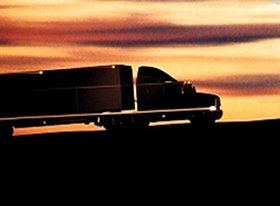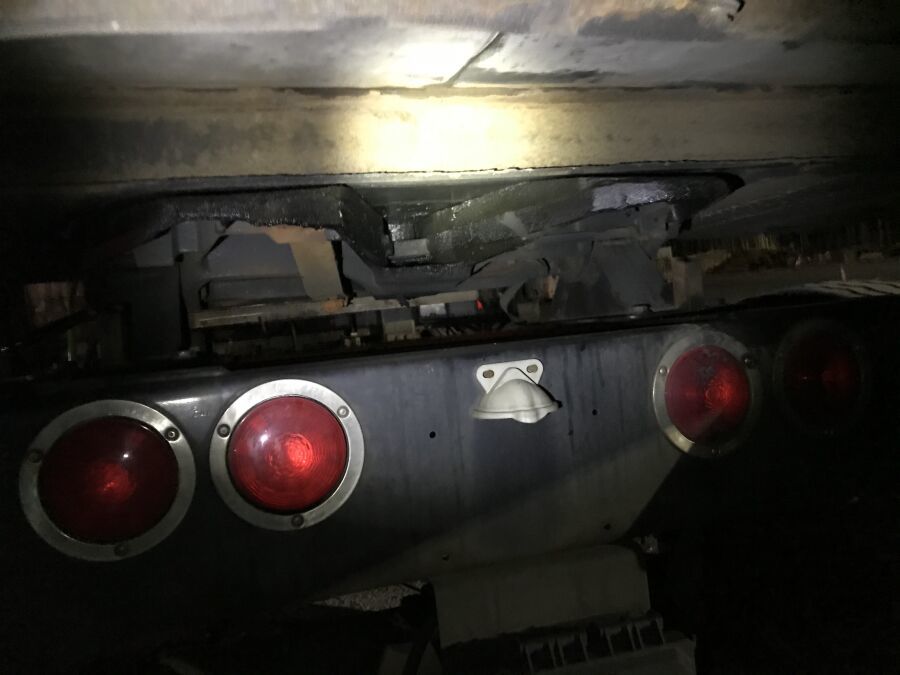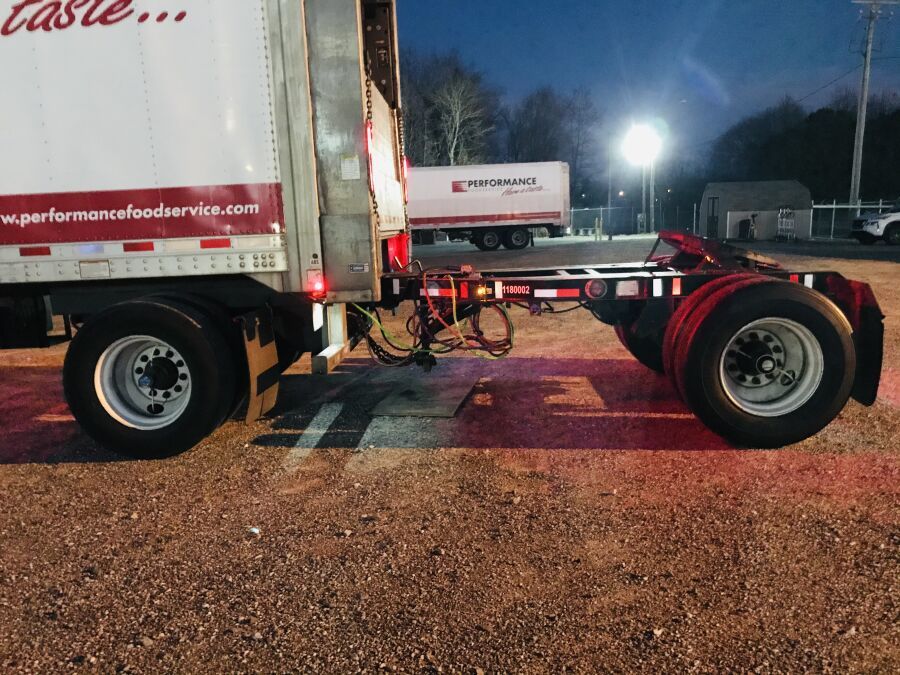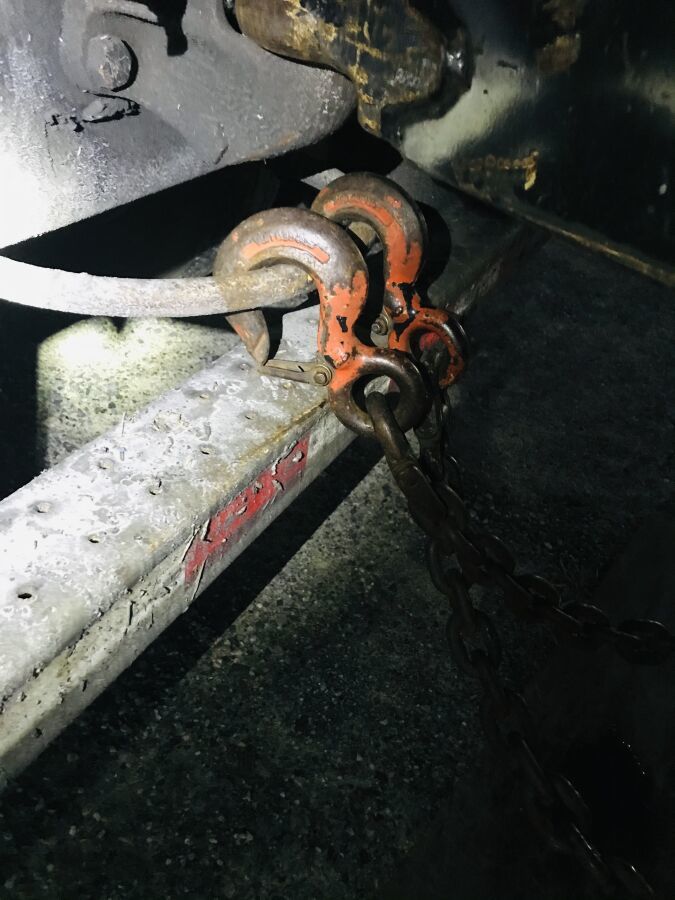Running Doubles
Topic 31237 | Page 10

My primary yard is unpaved; stone and sand surface and not level. Pushing the dolly for more than a foot or so is out of the question, when the surface is wet from rain impossible.
Back when I pulled doubles I was without a pintle hook for over a year at one point and did just that.
Our dollies with 3,000 lbs. I normally move them with tractor, but sometimes I'll do it by hand so I can get out quickly.
Meaning, I arrive at my destination and I know what I have to take back. After dropping my tail I line up the dolly while it's still attached to my lead and push it back to my new tail by hand.
Doubles:
Refers to pulling two trailers at the same time, otherwise known as "pups" or "pup trailers" because they're only about 28 feet long. However there are some states that allow doubles that are each 48 feet in length.

I’m a Licensed Master Captain, but my career has spanned logistics via Road, Rail, Air and Sea. General cargo to project cargo. Re LTL trailer sets, couple questions: 1.) What’s the advantage over say a 53 Ft
2.) Reading replies; drivers who prefer to do their own setups versus presets, I think it answered my 2nd question; it’s a stable rig connection if done correct. I saw a video of FedEx twins, driver enters yard and doesn’t notice No. 2 fully disconnect & kept going. The thought of that at 60-70 Mph on a highway … I realize without anyone seeing this video, trying to answer how he made it back & then No. 2 came loose, impossible to answer.
But how often can a disconnect happen?
LTL:
Less Than Truckload
Refers to carriers that make a lot of smaller pickups and deliveries for multiple customers as opposed to hauling one big load of freight for one customer. This type of hauling is normally done by companies with terminals scattered throughout the country where freight is sorted before being moved on to its destination.
LTL carriers include:
- FedEx Freight
- Con-way
- YRC Freight
- UPS
- Old Dominion
- Estes
- Yellow-Roadway
- ABF Freight
- R+L Carrier
OOS:
When a violation by either a driver or company is confirmed, an out-of-service order removes either the driver or the vehicle from the roadway until the violation is corrected.

Two or three 28s can hold more cubes of freight than a 53’ van. However that’s not the primary reason for their use; it’s about handling less than a 48-53’ trailer load of freight on a smaller trailer and shuttling or moving two-three trailers to a remote yard or terminal for eventual customer delivery or other logistical movement. There is additional content regarding this subject in the thread.
Can a disconnect happen. Possibly. There are two convention points; pintle hook on rear of lead unit and the fifth wheel of the dolly. I perform several safety checks and inspections on the pintle hook, ensuring it’s secure. Same for the fifth wheel/kingpin coupling.


I’m a Licensed Master Captain, but my career has spanned logistics via Road, Rail, Air and Sea. General cargo to project cargo. Re LTL trailer sets, couple questions: 1.) What’s the advantage over say a 53 Ft
2.) Reading replies; drivers who prefer to do their own setups versus presets, I think it answered my 2nd question; it’s a stable rig connection if done correct. I saw a video of FedEx twins, driver enters yard and doesn’t notice No. 2 fully disconnect & kept going. The thought of that at 60-70 Mph on a highway … I realize without anyone seeing this video, trying to answer how he made it back & then No. 2 came loose, impossible to answer.
But how often can a disconnect happen?
Terminal:
A facility where trucking companies operate out of, or their "home base" if you will. A lot of major companies have multiple terminals around the country which usually consist of the main office building, a drop lot for trailers, and sometimes a repair shop and wash facilities.
LTL:
Less Than Truckload
Refers to carriers that make a lot of smaller pickups and deliveries for multiple customers as opposed to hauling one big load of freight for one customer. This type of hauling is normally done by companies with terminals scattered throughout the country where freight is sorted before being moved on to its destination.
LTL carriers include:
- FedEx Freight
- Con-way
- YRC Freight
- UPS
- Old Dominion
- Estes
- Yellow-Roadway
- ABF Freight
- R+L Carrier
OOS:
When a violation by either a driver or company is confirmed, an out-of-service order removes either the driver or the vehicle from the roadway until the violation is corrected.
When you supply air to the dolly, there's a ram that holds the eye in place. As long as air is being supplied, it'll hold the dolly in place even if the pintle hook opens. In the event it comes loose, you have chains attached to the lead to make sure your rear doesn't go barreling down the highway.
As for the FedEx guy that dropped his rear, it's possible that it is never hooked properly or somebody tampered with it and a walk around was not conducted. Whenever I walk away from my set, I walk around it to make sure nobody pulled the fifth wheel handle and nobody messed with the air valves.
OOS:
When a violation by either a driver or company is confirmed, an out-of-service order removes either the driver or the vehicle from the roadway until the violation is corrected.

Interesting, our dollies do not have the air actuated ram; although we do have heavy chains. And they will hang on long enough to hopefully land somewhere.
Good points Banks. I do the same, multiple walk around. Cannot be too careful with these things.
When you supply air to the dolly, there's a ram that holds the eye in place. As long as air is being supplied, it'll hold the dolly in place even if the pintle hook opens. In the event it comes loose, you have chains attached to the lead to make sure your rear doesn't go barreling down the highway.
As for the FedEx guy that dropped his rear, it's possible that it is never hooked properly or somebody tampered with it and a walk around was not conducted. Whenever I walk away from my set, I walk around it to make sure nobody pulled the fifth wheel handle and nobody messed with the air valves.
OOS:
When a violation by either a driver or company is confirmed, an out-of-service order removes either the driver or the vehicle from the roadway until the violation is corrected.

Photos showing chains:



OWI:
Operating While Intoxicated
This is a fantastic thread! Just finished reading through the whole thing. I don’t know if I’ll ever pull doubles but I have lots of respect for those of you that do.
G you gotta try some composite toe boots when those wear out. I’ve always worn steel toe and my toes freeze in the snow. These Irish Setters I have now are composite toe and my toes didn’t get cold even untarping in a foot of snow in the Rockies.
Doubles:
Refers to pulling two trailers at the same time, otherwise known as "pups" or "pup trailers" because they're only about 28 feet long. However there are some states that allow doubles that are each 48 feet in length.
HOS:
Hours Of Service
HOS refers to the logbook hours of service regulations.
Thank you for the tip PianoMan. I just bought my boots 🥾 and so far they are serving me well. I’m no longer working in the frigid temps I had while running Walmart.
How ‘bout posting some pics of your gig. Take care brother.
This is a fantastic thread! Just finished reading through the whole thing. I don’t know if I’ll ever pull doubles but I have lots of respect for those of you that do.
G you gotta try some composite toe boots when those wear out. I’ve always worn steel toe and my toes freeze in the snow. These Irish Setters I have now are composite toe and my toes didn’t get cold even untarping in a foot of snow in the Rockies.
Doubles:
Refers to pulling two trailers at the same time, otherwise known as "pups" or "pup trailers" because they're only about 28 feet long. However there are some states that allow doubles that are each 48 feet in length.
HOS:
Hours Of Service
HOS refers to the logbook hours of service regulations.I’m no longer working in the frigid temps I had while running Walmart.
No need to brag
New Reply:
New! Check out our help videos for a better understanding of our forum features

















Preview:
This topic has the following tags:
Changing Careers Choosing A Trucking Company Doubles and Triples Linehaul LTL Driving Photos Trailers Truck Equipment







 TT On Facebook
TT On Facebook
I still love this thread.
One of y'all needs to either upload a video of hooking pintle hooks, dollies, and such ... or guide me to a good one, on the Y'Tube!
TIA, (means Thanks in Advance, Ms. Laura, hehehe...)
~ Anne ~ :)